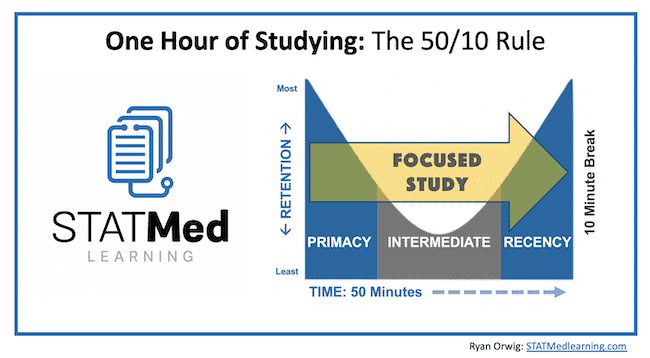The #1 Hack for Improving Study Efficiency

By Ryan Orwig, Founder of STATMed Learning
When I meet struggling medical students looking for help, the easiest strategy I can introduce is the 50/10 Study Rule. This rule simply breaks every hour of study into TWO parts:
- The 50-minute STUDY part: Dedicated exclusively to on-task studying. Turn your phone off, stay off the Internet, and avoid distractions. And seriously … turn off your phone!
- The 10-minute BREAK part: An absolute break from studying. Anything goes here. Multitask your heart out, gorge yourself on social media, exercise, check your phone, rest, text your friends, call your mom, you name it. Just be ready to re-start studying as soon as the 10 minutes ends.

The TOP SEVEN reasons I love the 50/10 Med Study Rule are because it:
1) Installs RULES: Let’s face it, most of my med students simply didn’t need study “rules” prior to med school. Why? They were smart enough to “just do it,” as the classic Nike slogan goes. But if they start to struggle in med school, past success is irrelevant, and now the lack of rules is a problem. The 50/10 Rule is the most actionable strategy anyone can quickly implement.
2) Eliminates INTERRUPTIONS & DISTRACTIONS: We live in the most distractible era in history. Your phone probably buzzed while you were reading this article. Using the 50 minutes to block out all interruptions can make a staggering difference. Then on your 10-minute break, feast on whatever you want to get your fix!
3) Ends MULTITASKING when STUDYING: Multitasking when studying is toxic. The 50/10 Rule mandates that you stay on task when studying during the 50 minutes, then go on a multitasking, multimedia bender during your 10-minute break. Mix and repeat.
4) Provides concrete END-POINTS when STUDYING: When I ask incoming STATMed Class students how they know to take a break or otherwise end a study session, they always give confused answers like:
- “I stop when my head hits the table”
- “I quit when I can’t see straight anymore”
- “When I fall asleep”
- “When I realize I have no idea what happened to the last hour”
- “If I accidentally get up, wander around, and never make it back to the desk….I guess I’m on a break”
- “When I am done … but, I rarely ever feel done, so … I don’t know…is this a trick question?”
- No one teaches smart students how to study, and it drives me crazy. I like how the 50/10 rule gives my med students concrete end-points to work toward, removing vagaries and making sustained studying achievable.
5) Boosts RETENTION: Along with improving retention by cleaning what happens when we study, this structure also creates more PRIMACY and RECENCY events (remembering more from the beginning and ending, respectively, of a list of memorized items). These memory phenomena are extrapolated from the Serial Position Effect, which I like using as I try to hack our brains to get more retention out of every facet available to us!
6) Defines BOUNDARIES: Many of my students are using “fuzzy” boundaries at best regarding what’s allowed and not allowed when they study. The 50/10 Rule creates stark boundaries between what can and cannot happen DURING the 50-minute study session:
- Allowed: Read and mark Dr. Smith’s biochem PowerPoint, make a MEMORY PALACE for lysosomal storage diseases, do some retrieval practice on the flow chart for glycolysis, etc.
- Obviously not allowed: Text my friends, check my phone, scan through Facebook, shop online, etc.
- Not-so-obviously not allowed: Build schedule for next week, prepare for meeting with my advisor, send out study group emails, search for videos that explain a single bullet point on Dr. Singh’s lecture, etc.
7) Augments decision-making and prioritization: There is never enough time to study everything in med school, so figuring out what to study is a skill in and of itself. Since the 50/10 Study compresses time, students are forced to ask themselves if their current task if both URGENT and IMPORTANT. While this will not solve all students’ issues, it is a critical piece of the puzzle that must be fostered. The 50/10 Rule allows for this growth.
As with any skill, the 50/10 Med Study Rule is just one tool in an elaborate matrix of study skill sets. However, it is a great place to start for any med student, as well as any other medical professional student (veterinarian, Pharm D, PA, dentistry, etc.), who is frustrated with not getting enough done in a given week, day, or hour of study.
Ready to improve your studying and get better results? Get in touch!
Updated from April 28, 2016 version on April 16, 2020